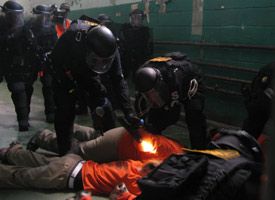| This article is part of the C1 2010 Mock Prison riot report: |
By Luke Whyte
In the spring of 1997, the emptied cell blocks of the decommissioned State Penitentiary in Moundsville, West Virginia, exploded once again with sounds of inmates shouting, flash-bangs cracking, and CERT teams marching. Like a match in a gas tank, the first ever Mock Prison Riot came to life.
Just three riot scenarios were played out by officers at the first Mock Prison Riot (MPR). Four vendors showed up to fill out the technology showcase. Around 70 people attended.
From May 2nd to 5th, 2010, the 14th annual MPR took place. Upwards of 70 different riot scenarios were played out by CERT teams from Florida to Singapore. They tested technologies developed by some 120 vendors. And, in total, more than 1,400 people attended.
So, why the growing excitement? Well, it wouldn’t be much of a stretch to say that by combining state of the art technologies with life-like riot scenarios, the organizers of the Mock Prison Riot are forging a path into what could be a whole new era of correctional training.
|
Members of the Passaic County, N.J., Sheriff’s Dept. check an inmate for weapons during a riot scenario. (Luke Whyte photo) |
What makes it special?
For both companies that develop law enforcement technologies and correctional professionals that are part of Emergency Response Teams, there really is no other experience quite like the MPR. Here are the three main reasons this event is different:
Reason #1: Realistic riot training tailored to your needs
“It’s hard to run cell block emergency drills when your cells are full of prisoners,” said the team leader from FMC Lexington in Kentucky. This is exactly what makes the MPR so useful.
When registering online for the MPR, participating CERT teams design the riot scenarios they’ll play out at the event. Thus, it’s possible to tailor your training at MPR to mimic emergencies that could actually unfold at your facility. After you register, the MPR organizers add your scenario to the schedule and, when the time comes for action, they provide you with volunteer inmates to drill the scenario in the actual facilities of the Moundsville penitentiary.
This year, the MPR team also added a 3-D model of the penitentiary to their website, allowing attendees to virtually survey the facility before designing the scenarios they wanted to drill, further improving the effectiveness of their training.
“We also added a penitentiary-wide camera system to capture this year’s demonstrations and scenarios,” said Sharon Goudy, MPR project manager. “These are the ways that we’ve been trying to modernize the experience for the practitioners.”
Reason #2: It’s “where technology meets mayhem”
The above quote was the slogan for the 2010 MPR, and, in many ways, it captures the essence the event.
“Our primary goal is best described as the marriage of technology developers and correctional practitioners,” said Goudy. In other words, by placing new technologies in the hands of real officers drilling riots in an actual penitentiary, both officers and vendors get an excellent insight into the value of the product.
“What we are after is the feedback of the people who will actually be using this technology in the field,” Goudy says. “We try to get the technology into the hands of the practitioner no matter what stage of development it is at.”
It works like this: Law Enforcement vendors from around the country bring their latest products and technologies to the MPR exhibition hall. CERT teams are then able to pick and choose from these products and test them out in their life-like training scenarios.
This creates a win-win environment for both officers and vendors. The officers are able to test if a certain product may be of use to them at their facility and the vendors are able to show the value (and discover the limitations) of their latest technologies.
In the long run, the hope is that this approach to training and technology will lead to a general increase in the effectiveness of law enforcement products entering the corrections market.
Reason #3: It won’t cost you a penny
All correctional professionals who attend the MPR are granted access and allowed to develop and participate in riot scenarios completely for free. The only thing you’ll have to pay for is lodging and transportation from your facility to the event.
“Our vision has always been clear,” says Goudy. “We get to work with some of the greatest people there are — the LEOs and the technology specialists. We love our jobs we’re very happy to be able to offer this program.”
Is it for you?
The dates for the 2011 Mock Prison Riot have already been announced – May 1st through 4th. Right now, the event organizers are involved in what’s called their “after action process”; getting feedback from both the practitioners and technology developers who attended this year’s Riot in order to help build an even better experience for next year’s participants.
If you think the Mock Prison Riot sounds like it might benefit your Emergency Response Team, check out the rest of this special report and then visit the Mock Prison Riot website at http://mockprisonriot.org/.
Teams we spoke to at this event recommended talking to your Lieutenant (or who ever else would ultimately make the decision to go) as early as possible, increasing the chances that your visit will be squeezed into the budget.













